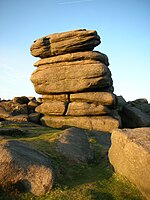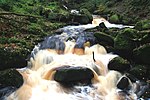Master's Edge
Climbing areas of EnglandClimbing routes

Master's Edge is an 18-metre (59 ft) gritstone arête that is a rock climbing route in the "Corners Area" of Millstone Edge quarry, in the Peak District, England. When English climber Ron Fawcett completed the first free ascent of the route on 29 December 1983, it was graded E7 6c, and one of the hardest traditional climbing routes in the world; it remains one of the hardest gritstone climbs.
Excerpt from the Wikipedia article Master's Edge (License: CC BY-SA 3.0, Authors, Images).Master's Edge
A6187, Derbyshire Dales
Geographical coordinates (GPS) Address Nearby Places Show on map
Geographical coordinates (GPS)
| Latitude | Longitude |
|---|---|
| N 53.3212 ° | E -1.6291 ° |
Address
A6187
S32 1DA Derbyshire Dales
England, United Kingdom
Open on Google Maps










